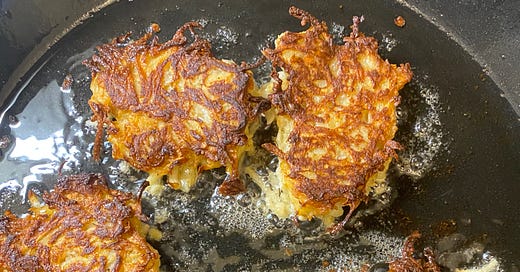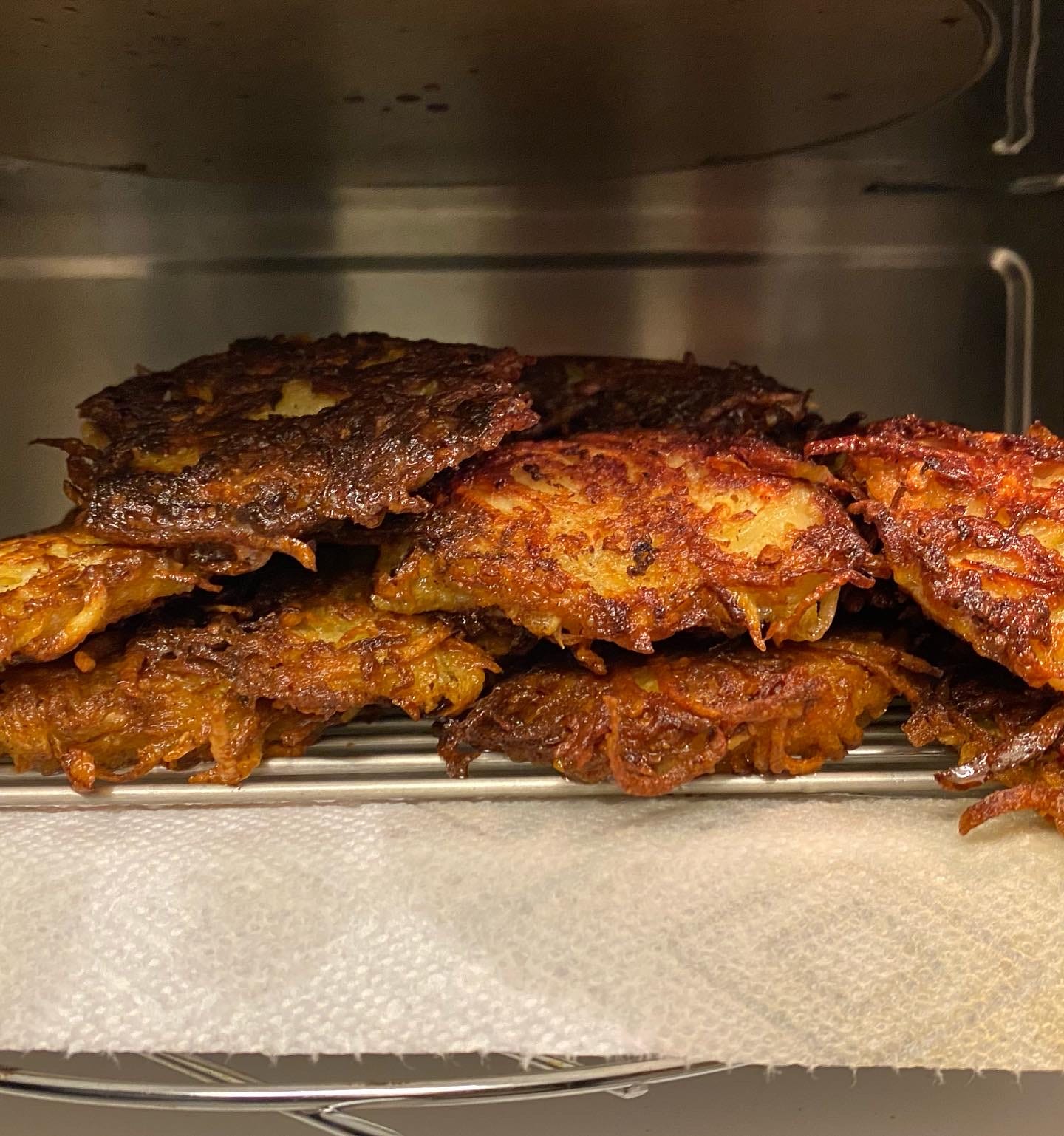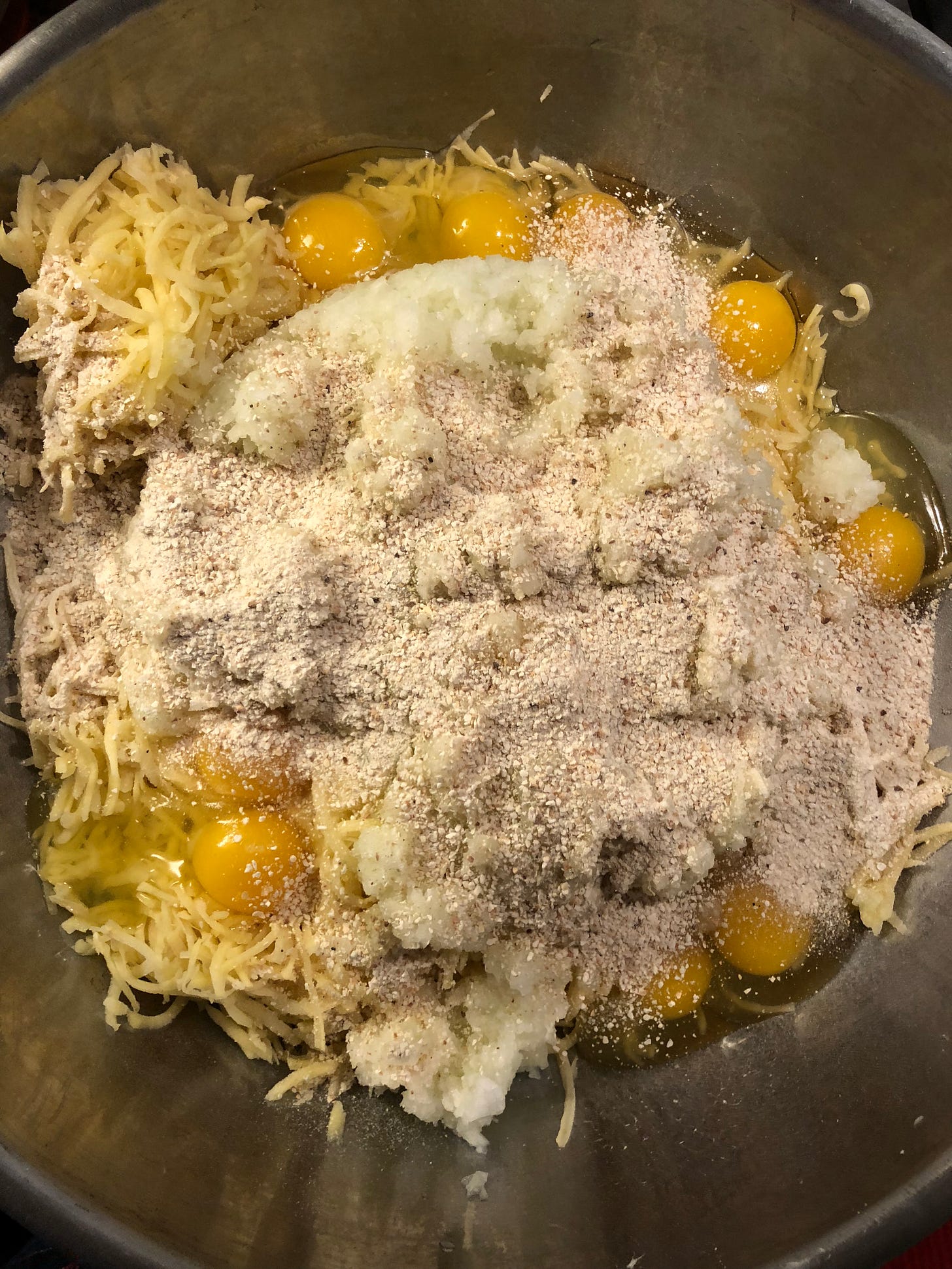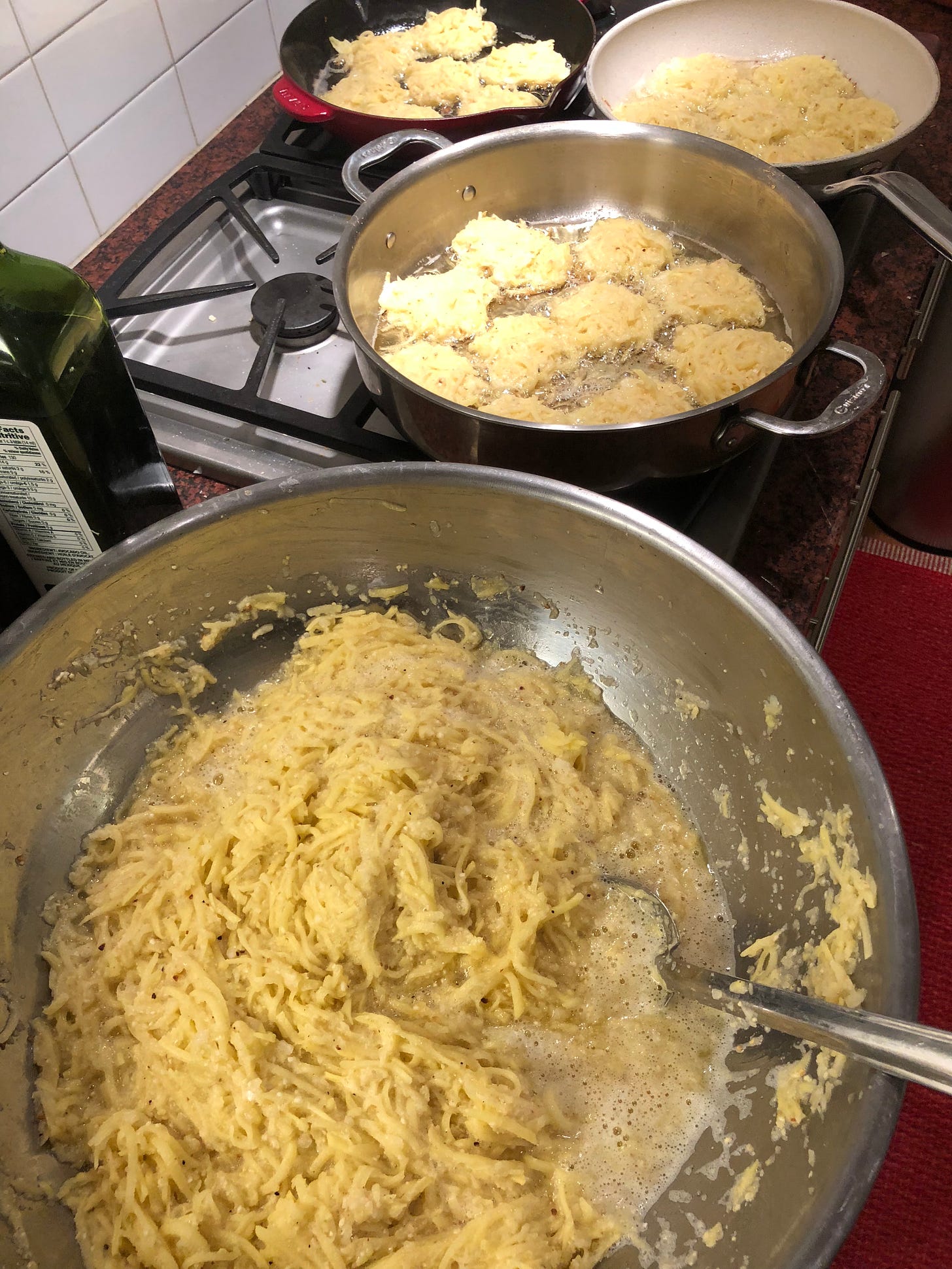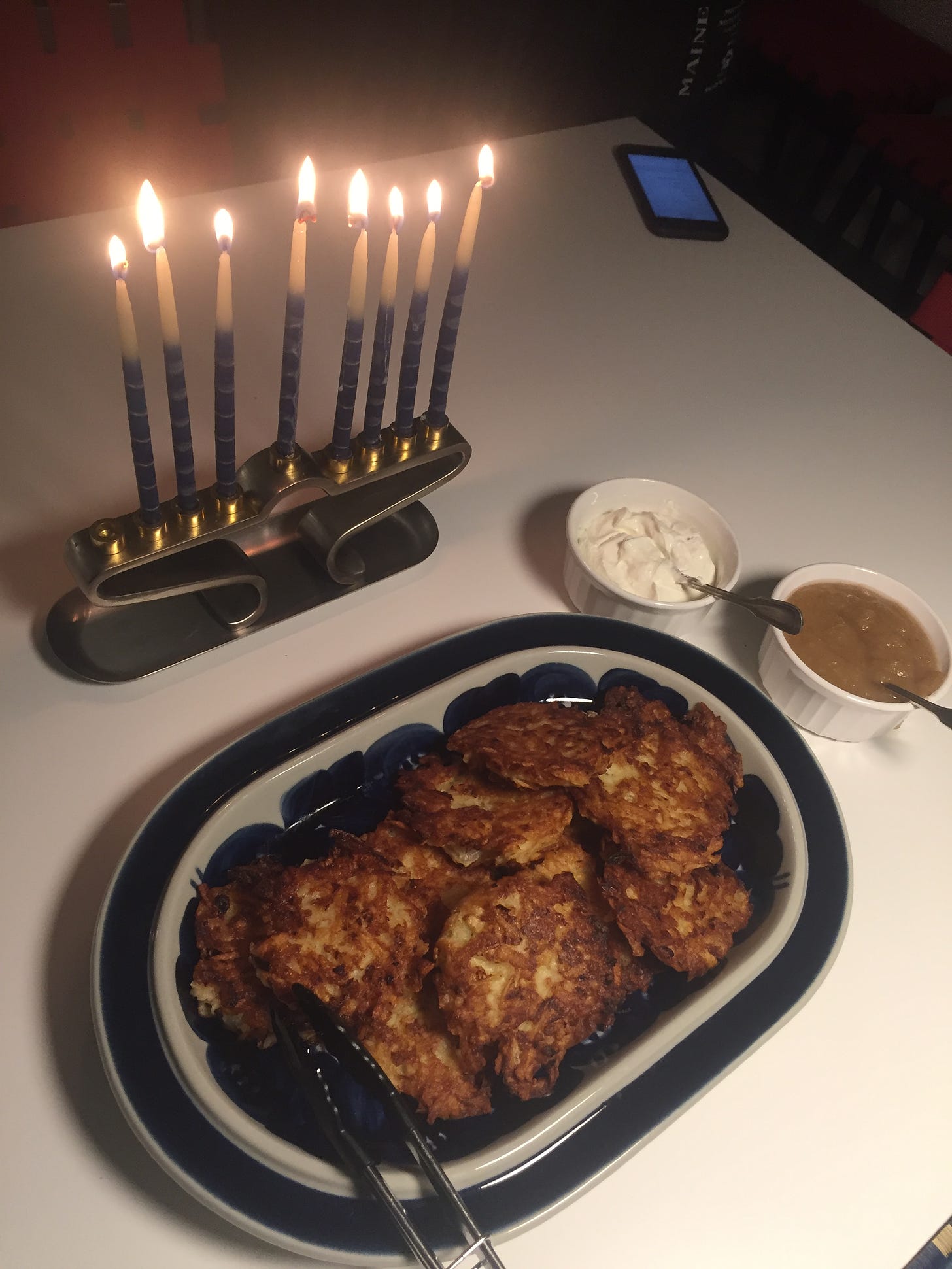My Little Latke
Pancake Party Redux, Potato or Cheese, with Latkes It’s About the Oil, Apple Sauce
We are back to pancakes in Issue #27, but not your standard issue breakfast pancakes (see Issue #9 for those). I’m talking potato pancakes, latkes, a symbolic (and delicious) food Ashkenazi Jews eat on Chanukah. For my American readers, first comes Thanksgiving, of course. But save room for fried food. Happy holidays to everyone. Remember, a subscription to Kitchen Sense makes a great holiday gift, no matter your religion or latke preference. — Mitchell
The unusual confluence of Thanksgiving weekend and Chanukah in many Jewish American households will no doubt make for an extension of that unbutton-your-pants, bloated feeling that comes from overindulging on holiday food. To help you sustain it, last week I provided recipes for a few simple, traditional Thanksgiving sides (Brussels Sprouts with Bacon and Mashed Potatoes).
This week, I give you the recipe for Sonny Davis’s James Beard Award winning latkes. What? You didn’t know there was a James Beard Award for potato pancakes? No, this is not the result of the recent audit of the Beard Awards to make them more inclusive and transparent (click here for details about that and how to enter, but hurry, you only have until November 30). My award was given at the First Annual James Beard Foundation Latke Cook-Off, which was held at the James Beard House in 1995. I competed in the amateur category and walked off with the award for Best Amateur Latke and the overall People’s Choice awards. (As the winner, the next year I was invited to cook Chanukah dinner at the Beard House, which is where the photo below was taken. It was the first of seven dinners I headlined at the Beard House during my tenure there.)

Sonny Davis was my mother (may her memory and her latkes be a blessing). Her secret? One onion for every two potatoes. The recipe was published in The Mensch Chef and on the James Beard Foundation website, where, I was told, it was one of their 10 most popular recipes of all time.
But let’s talk about latkes for a moment. They are not a universal symbol of Chanukah, it turns out. This came a surprise to me as an adult. There were, in fact, no potatoes found after the temple was destroyed. Instead, there was oil, enough for one day that miraculously burned for eight. Enter a holiday where things fried in oil—potato pancakes, cheese pancakes (!), jelly donuts, samosas and pakoras (see Esther David’s new book, Bene Appétit: The Cuisine of Indian Jews)—are supposed to be eaten. It’s god’s will you eat fried foods. S/he is, indeed, a benevolent god.
Aside: Years ago, when fat was still a nutritional no-no, people started baking their potato latkes in little muffin tins to make them “healthier.” Not only were these sad. ersatz latkes unappealing, they totally missed the point, which is THE OIL.
Anyway, here’s the recipe for my mother’s laktes. I will be be making a very large pile of them, to be sure. I don’t know why, but every year we question, “Latkes are so delicious, why don’t we make latkes all year long?” But we never do, perhaps because it’s enough to eat yourself sick on them just once a year.
RECIPE: Sonny’s Special Potato Latkes
(Makes a pile; you can double, triple, or quadruple as needed)
4 large potatoes (about 2 pounds), such as russet or Yukon Gold, peeled and cut into large chunks
2 large onions (about 1 pound), halved
2 large eggs, lightly beaten
1/4 cup matzoh meal
2 1/2 teaspoons salt, or to taste
1/2 teaspoon freshly ground black pepper
3/4 cup peanut or other good vegetable oil, for frying
Using the medium shredding blade of a food processor, grate a couple of pieces of potato, laying them horizontally in the feed tube to maximize the length of the strands. Next grate half an onion. Alternate the potatoes and onions in the feed tube until everything is grated. The onions will turn to mush, but their juices will help keep the potatoes from turning brown. Pick out any large pieces.
Lay a clean dish towel inside a large bowl and transfer the grated mixture into the towel. Roll up the towel lengthwise and wring out as much liquid as possible (you can do this over the bowl or right over the sink).
Transfer the grated mixture to a clean bowl. Add the eggs, matzoh meal, salt, and pepper, and mix well. In a large cast-iron or nonstick skillet, pour about 1/8 inch of oil and heat on medium high. The oil is hot enough when a piece of potato sizzles when added. Form a trial latke with a tablespoon of the mixture. Fry until brown, taste, and adjust the seasonings.
To form the latkes, scoop up about 1/2 cup of the mixture with your hands and loosely pat it into a pancake about 1/2-inch thick, leaving a few straggly strands around the edge. (As you work, liquid will accumulate in the bowl. Squeeze out the excess to form a compact pancake). After shaping each latke, slip it into the hot oil and flatten gently with the back of a spatula. Fry until deep golden brown, at least 10 minutes on each side to be sure the center is fully cooked. The latkes may take more or less time depending on how many you fit into your pan and how hot your stove is, but I've never been able to get the total cooking time under 15 to 20 minutes a batch. If the edges darken very quickly, lower the heat. To prevent excess oil absorption, flip each latke only once. Add oil between batches as needed, making sure the oil heats up again before frying more latkes. Drain the latkes on paper towels or a clean brown paper bag. Serve immediately.
Note, to make the latkes gluten free, you can substitute 3 tablespoons potato starch for the matzo meal.
But Wait! Cheese Latkes!
Recently, my friend Bonnie Stern reminded me about cheese latkes, which were apparently the original Chanukah pancake. I had forgotten about them, even though I included a story and a recipe for cheese latkes in The Mensch Chef. It was a good reminder, and these sweet, little pancakes make a delicious breakfast-for-dinner or breakfast breakfast. For my other breakfast pancake recipes, see here.
RECIPE: Cheese Latkes
(Makes 16, 3-inch latkes)
1 cup (7 ½ ounces) farmer’s cheese
¼ cup (2 ounces) cream cheese, at room temperature
3 eggs
1 cup milk
1 cup matzo meal
1 teaspoon kosher salt
¼ cup white sugar
1 teaspoon vanilla extract
5 tablespoon unsalted butter, for frying
Cinnamon sugar for dusting
In a mixing bowl, combine the farmer’s and cream cheeses, mixing with a wooden spoon until smooth. Beat in the eggs, milk, matzo meal, salt, sugar, and vanilla. Let sit about 5 minutes for the matzo meal to swell. (Bonnie gave me this tip.)
Heat 1 tablespoon of the butter in a large frying pan set over medium-high heat. Drop ¼-cupfuls of the batter into the pan to form pancakes, being careful not to crowd the pan. If necessary, flatten the batter with an offset spatula. When the panckes have browned on the bottom and begun to bubble slightly, about 4 minutes, carefully flip them over to cook the second side. They should take an additional 2 or 3 minutes of cooking. Remove to a clean plate or cookie sheet and keep warm. Continue frying until all the latkes are done. Serve dusted with cinnamon sugar.
And For Garnish
Whether cheese or potato, there are no latkes that should be served not slathered with sour cream and apple sauce. Buy the sour cream you like. (If you can find it, locate Ronnybrook Farm Dairy’s sour cream, which is a relatively new addition to their product line, is so rich and thick and flavorful that I now always have some in my refrigerator.)
As for the apple sauce, I’m sorry, but if you’ve gone to the trouble of making latkes, only homemade apple sauce will do. It’s simple. Here’s how I make mine, which I always make in a large batch with a vegetable mill so I have plenty to eat through Chanukah and beyond.
RECIPE: Apple Sauce
10 cooking apples (about 4 pounds), an assortment of varieties for a more complex flavor, such as Northern Spy, Cortland, Empire, Golden Delicious, Winesap, Macintosh, or whatever you like, rinsed
½ teaspoon ground cinnamon
2 teaspoons vanilla extract
Juice of 1 lemon
Quarter the unpeeled apples and place them in a large pot with 2 tablespoons of water. Set over low heat, cover, and let simmer for 30 to 40 minutes, until the apples are soft. Set a vegetable or food mill over a mixing bowl. Spoon some of the cooked apples and their juices into the mill and turn the handle clockwise to purée. As the seeds and peels begin to build up under the blade, turn the handle counterclockwise to loosen and discard. Repeat until all of the apples are puréed. Add the cinnamon, vanilla, and lemon juice, mix well, and cool. Adjust the seasoning to taste.
Alternately, you can peel, core, and dice the apples and cook them the same way, until soft. Season to taste. This applesauce will remain chunky, which I like, too.
Jelly donuts, called sufganyot, are Sephardi Jewish Chanukah tradition. This was not our tradition, but who would say no to a fresh jelly donut? But for a recipe for those you may have to wait until next year.
